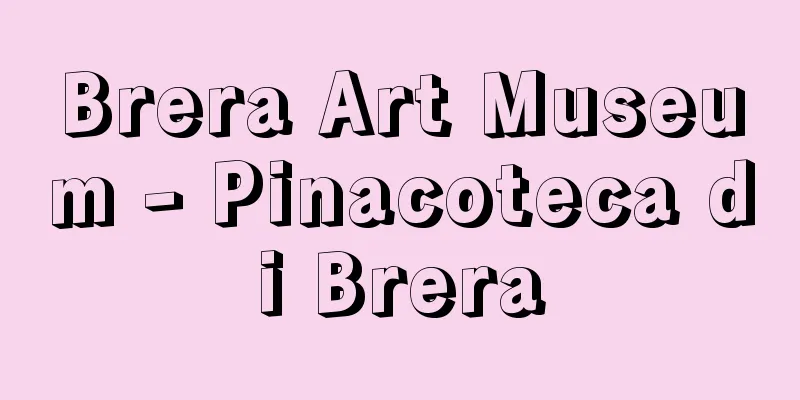Brera Art Museum - Pinacoteca di Brera

|
A Milan art gallery that focuses on Italian paintings from the 13th to 20th centuries. The name "Brera" comes from the fact that it was located on the outskirts of town (brayda del guercio) when it was founded. The museum space is located on the second floor of a palace (palazzo) that was originally built for Jesuit monks in the mid-17th century. The art school (Accademia) on the first floor is the predecessor of the museum, so to speak. Maria Theresa, who conquered the Jesuits, envisioned a comprehensive cultural institution there that would include a library, a weather station, and a literary and scientific research institute, and it was founded as one of these institutions in 1776. Since the time of its first president, Bianconi, the art school has collected art pieces as educational materials, but with the abolition of religious facilities due to political changes in the early 19th century, even more works have been collected. Based on these collections, a museum was opened under the management of the Accademia in 1809 by order of Napoleon, Emperor of France and King of Italy, and in 1813 the museum exchanged its collection with the Louvre, adding northern paintings. Even after it became independent from the Academy of Fine Arts and became a municipal art museum in 1882, it continued to expand its collection, including modern and contemporary paintings. The majority of the works in the collection are from the Venetian and other Northern Italian Renaissance paintings, including Crivelli's "The Coronation of the Virgin," which is full of the luxurious decorativeness of late Gothic, Mantegna's "Dead Christ," known for its foreshortening technique, the large-scale works by the brothers Gentile and Giovanni Bellini, who contributed to the establishment of the Venetian style of oil painting, including "The Preaching of St. Mark at Alexandria," a pioneering urban landscape painting, Giovanni Bellini's "Pietà," Carpaccio's "The Presentation of the Virgin in the Temple," which depicts a religious story set in a setting that skillfully uses architecture, Titian's "Portrait of Count Antonio Porcia," Tintoretto's "The Discovery of the Remains of St. Mark," Veronese's "The Baptism and Temptation of Christ," and Vincenzo Foppa's "The Baptism and Temptation of Christ." The changes in style can be traced through works by 15th and 16th century Lombard painters such as Foppa (1427/30-1515/16) and Bernardino Luini. Other representative works on display include the polyptych "The Coronation of the Virgin and All Saints" by Gentile da Fabriano, a representative of the International Gothic style; Piero della Francesca's "Montefeld Altarpiece," with its eye-catching ostrich eggs hanging from the ceiling; "The Marriage of the Virgin," a work that summarises Raphael's apprenticeship period and beautifully combines the graceful and delicate figures inherited from his teacher Perugino with the perspective space of Brunelleschi-style buildings; Caravaggio's masterpiece "The Supper at Emmaus," a representative work of the Italian Baroque; and from the modern era, sculptures by Medardo Rosso, and works by central figures of the Futurist movement such as Boccioni and Carrà, as well as Morandi and Marini, some of the most representative works of Italian art. [Kenjiro Hosaka] "La Musée 42 - Enjoying the World's Masterpieces and Art Museums at the Brera Gallery" (1994, Kodansha) "Weekly World Art Museums 67: The Brera Gallery" (2001, Kodansha) [References] | | | | | | | | | | | | | | | | | |Source: Shogakukan Encyclopedia Nipponica About Encyclopedia Nipponica Information | Legend |
|
ミラノにある、13世紀から20世紀までのイタリア絵画を中心とした絵画館。「ブレラ」の呼称は、創立当時は町はずれ(brayda del guercio)に位置していたことに由来する。美術館のスペースは、もともと17世紀のなかばにイエズス会の修道士のために建てられた宮殿建築(パラッツォ)の2階に位置する。1階にある美術学校(アカデミア)は、いわば美術館の前身で、イエズス会を制圧したマリア・テレジアが、そこに図書館、測候所、文学・科学研究所などからなる総合文化機関を構想し、1776年その一機関として設立された。美術学校は、初代学長ビアンコーニ以来、教材として美術品を収集していたが、19世紀初頭の政治変革による宗教施設などの廃止に伴い、さらに多くの作品が集まることとなった。そうした所蔵品をもとに、フランス皇帝にしてイタリア王でもあったナポレオンの命によって、1809年アカデミアの管理下に美術館が開設され、1813年にはルーブル美術館と収蔵品が交換されて北方絵画が加わった。1882年美術アカデミアから独立して市立の美術館となった後も、近現代の絵画など収蔵品の充実が図られてきた。 作品群の中心を占めるのはベネチア派など北イタリアのルネサンス絵画で、後期ゴシックの豪華な装飾性を湛(たた)えるクリベッリの『聖母戴冠(たいかん)』、短縮法の表現で知られるマンテーニャの『死せるキリスト』、ベネチア派特有の油彩表現の確立に寄与したジェンティーレとジョバンニのベッリーニ兄弟による大作で、都市景観画の先駆的存在である『アレクサンドリアにおける聖マルコの説教』、ジョバンニ・ベッリーニの『ピエタ』、建築物を巧みに用いた設定で宗教的物語を描いたカルパッチョの『聖母の神殿奉献』、ティツィアーノの『アントニオ・ポルチア伯爵の肖像』、ティントレットの『聖マルコの遺骸(いがい)の発見』、ベロネーゼの『キリストの洗礼と試練』のほか、ビンチェンツォ・フォッパVincenzo Foppa(1427/30―1515/16)、ベルナルディーノ・ルイーニなど15~16世紀のロンバルディア地方の画家の作品などによって、その変遷を辿(たど)ることができる。 そのほか、国際ゴシック様式を代表するジェンティーレ・ダ・ファブリアーノによる多翼祭壇画『聖母戴冠と諸聖人』、天井から吊(つ)るされた駝鳥(だちょう)の卵が目を惹(ひ)くピエロ・デッラ・フランチェスカの『モンテフェルトの祭壇画』、ラファエッロの修行時代を総括する作品で、師ペルジーノ譲りの優美で繊細な人物と、ブルネレスキ様式の建物による遠近法的空間がみごとに融合した『マリアの結婚』、イタリア・バロックを代表するカラバッジョの代表作『エマオの晩餐(ばんさん)』、近現代では、メダルド・ロッソの彫刻や未来派の中心人物であるボッチョーニやカッラ、そしてモランディやマリーニというように、イタリア美術を代表する作品が展示されている。 [保坂健二朗] 『『ラミューズ42――世界の名画と美術館を楽しむ ブレラ美術館』(1994・講談社)』▽『『週刊世界の美術館67 ブレラ美術館』(2001・講談社)』 [参照項目] | | | | | | | | | | | | | | | | | |出典 小学館 日本大百科全書(ニッポニカ)日本大百科全書(ニッポニカ)について 情報 | 凡例 |
<<: Prairie - English spelling: prairie
Recommend
Carbohydrates - Gansuitananso
〘Noun〙 A general term for compounds made of carbon...
Albrecht, TH (English spelling) AlbrechtTH
...There are also local variations specific to ea...
Sun Yat-sen (English spelling)
…He was called the Father of the Republic of Chin...
Mesangium
…This gap is bridged by a thin membrane called th...
Hydrophobia
…Hydrophobia is a condition in which the throat s...
Personal freedom - freedom of the person
This refers to the freedom of a person from unjus...
Goldstein, Kurt
Born: November 6, 1878 in Katowice, Silesia [Died]...
Sacrifice - Gisei
Also called sacrifice. A religious act performed i...
Termination compensation - Uchikirihosho
When an employee is injured or falls ill due to wo...
Himorogi
In ancient times, it was called "Himoroki.&q...
Medici, L.II de' (English spelling)
… [Hideo Katayama]. … *Some of the terminology th...
Receipt of receipt - Uketorishomon
…However, as a medieval tax receipt for official ...
Gilles
…During the reign of Louis XIV, Molière, who was ...
Kawatana
…It is located on the north side of Omura Bay, bo...
Kyogamisaki Cape
A cape located at the northeastern tip of the Tan...
![Maruyama [town] - Maruyama](/upload/images/67cceca497108.webp)








